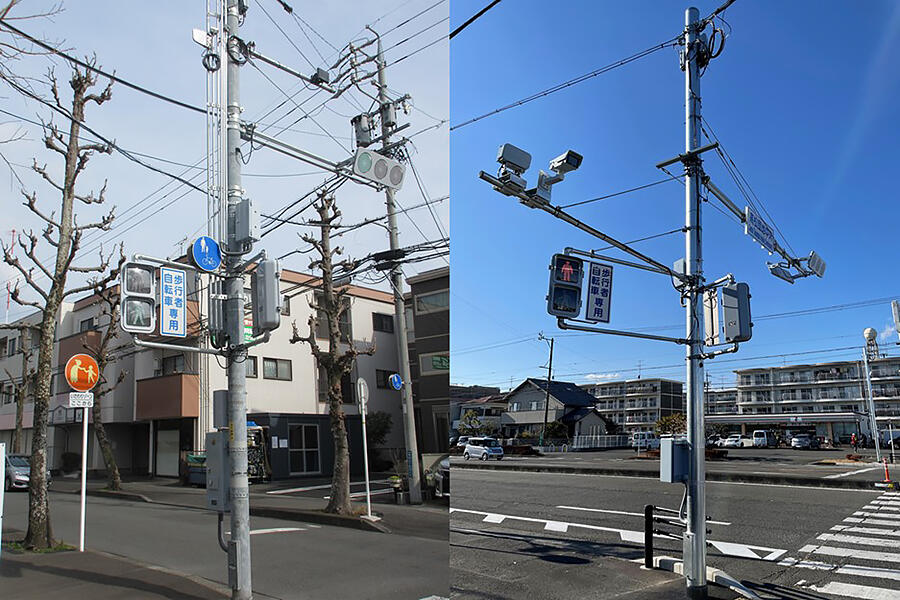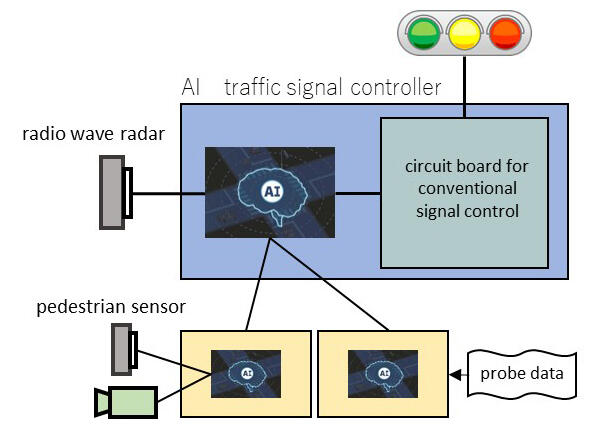NEDO (The New Energy and Industrial Technology Development Organization) and the UTMS Society are working to establish an adaptive autonomous and decentralized traffic control system incorporating artificial intelligence (AI). The system utilizes traffic information acquired from radio wave radars and probe information (location information). It is being created as part of the Realization of a Smart Society by Applying Artificial Intelligence Technologies project. This new system aims to realize a lightweight traffic control system at a lower cost than conventional systems through advanced centralized control methods. A demonstration experiment on actual roads began on March 24 at 12 intersections in Shizuoka Prefecture as part of these efforts. The experiment is being performed with cooperation from the National Police Agency and the headquarters of the Shizuoka Prefectural Police.

Source:UTMS Society of Japan
On most roads in Japan, advanced traffic controls are provided through a centralized traffic control system in which communication lines link traffic signals (traffic signal terminals) to central traffic control centers. However, in some areas, traffic signals are not linked in order to reduce maintenance costs. These decentralized signals provide only basic traffic controls. Even on roads with centralized traffic control systems, the increased maintenance costs of vehicle detectors, traffic signals, wired communication lines, and large-scale central control equipment create significant burdens.
NEDO and the UTMS Society are working on the Realization of a Smart Society by Applying Artificial Intelligence Technologies project to solve these problems. The project aims to utilize AI to realize an advanced yet light traffic control system at a lower cost than a centralized traffic control system. Specifically, information on pedestrians is generated using AI models learned based on traffic information and images obtained from radio wave radar near intersections. In addition, traffic information is generated from AI models based on probe information (location information) obtained from vehicles. This information is then input into autonomous and distributed traffic signals that use AI models to calculate optimal control parameters and control the signals. Additionally, the exchange of traffic signal control information between intersections establishes an adaptive autonomous and decentralized traffic control system that changes signal display times according to this information.
In the demonstration experiment, newly developed traffic signal controllers equipped with AI units were installed at 12 intersections in Shizuoka Prefecture. These will be used to verify whether suitable operations are possible by confirming the operations of the actual signal control equipment. In particular, the project plans to verify signal control performance at intersections, reductions in average time required to pass intersections, and pedestrian understanding at pedestrian crossings, among other parameters. The system is expected to provide time benefits and contribute to CO2 reductions by reducing average travel time by 15-20% compared to current traffic signals. Through this demonstration project, NEDO and the UTMS Society hope to establish low-cost, advanced traffic signal technologies through AI technologies.

Source:UTMS Society of Japan
The demonstration will also be linked with SIP Phase 2: Automated Driving (Expansion of Systems and Services) implemented by the Cabinet Office and managed by NEDO, and the PRISM Development of 5G Networks Utilizing Traffic Signals framework to establish the traffic control systems required in the era of Society 5.0, including automatic driving and high-speed, large-capacity communications. It will also contribute to the realization of sustainable, safe, and secure road transportation even in a low-growth society by reducing traffic congestion and system maintenance costs nationwide, along with realizing Mobility as a Service (MaaS), which integrates logistics and public transportation as services.
This article has been translated by JST with permission from The Science News Ltd.(https://sci-news.co.jp/). Unauthorized reproduction of the article and photographs is prohibited.




